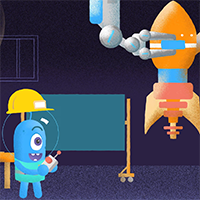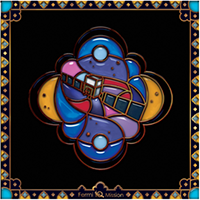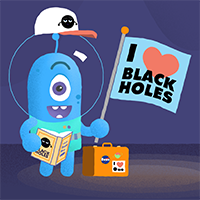Special Exhibits
Black Hole Field Guide Coloring Pages
Black Hole Field Guide Coloring Pages
Thinking about doing some black hole watching the next time you're on an intergalactic vacation, but you're not quite sure where to start? Well, look no further! We've taken a page from the best nature textbooks, added a dash of fun, and created our very own field guide to black holes. Check out the video series to learn about fancy and giant black holes and their companions. Then, color your own black hole birds!
Near-light-speed Travel Coloring Pages

So, you've just put the finishing touches on upgrades to your spaceship, and now it can fly at almost the speed of light. We're not quite sure how you pulled it off, but congratulations! Before you fly off on your next vacation, however, watch this handy video to learn more about near-light-speed safety considerations, travel times, and distances between some popular destinations around the universe. Then, color your own scenes from the video!
Fermi Stained Glass Coloring Book

The Fermi Gamma-Ray Space Telescope measures some of the highest energy bursts of light in the universe; watching the sky to help scientists answer all sorts of questions about some of the most powerful objects in the universe. This set of coloring pages are based on stained glass-inspired depictions of Fermi and its science.
Black Hole Safety Coloring Pages

Have you ever thought about visiting a black hole? We sure hope not. However, if you're absolutely convinced that a black hole is your ideal vacation spot, watch this video before you blast off to learn more about them and (more importantly) how to stay safe. Then, color your own scenes from the video!
Scientist Profiles

What do all scientists have in common? No, it is not that they wear pocket protectors or are geeks. It is that they all ask questions. Lots and lots of questions, since asking questions about what you see is one way to figure out how things work. Here at NASA's Goddard Space Flight Center, there are lots of people working towards a better understanding of the Universe around us. However, it is not always clear how particular observations can shed light on how our Universe works. Have you ever wondered how scientists work to understand the things in the skies around us? Have you ever wondered what the rocket scientists at NASA DO at work all day? Or how they spend their weekend?
You Be the Astrophysicist!

Many times, the best way to learn about something is to do it. We think the best way to learn about what an astrophysicist does would be to spend a day (or two or three) in the shoes of one. But since we don't have room for everyone who visits our web site to visit our lab, we've tried to do the next best thing. In these web pages, you will be given a real problem in astronomy which you solve by traveling through web pages, exploring different options and learning many different things along the way.
The Cosmic Distance Scale

This feature will give an impression of how immense our Universe is by employing a method used many times in "Power of 10" films - that is, starting with an image of the Earth and then zooming out towards the furthest visible reaches of our Universe. This is not, however, an exercise in "powers of 10" - on the contrary, our goal is to show you astronomical distances without scientific notation. We instead focus on the large number of zeros that are in astronomical distances when we measure them with a familiar unit like the kilometer. The number of zeros increase with each zoom, though not at a constant rate.


